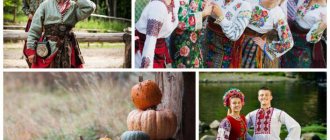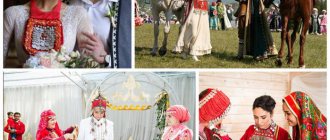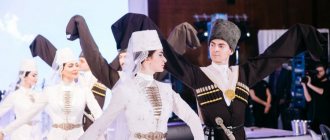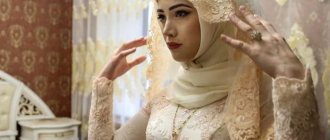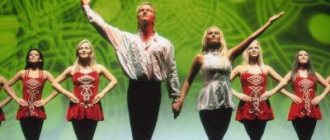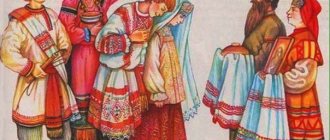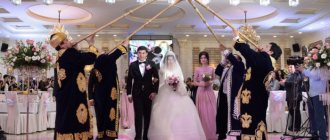A modern Adyghe wedding is just an echo of traditions that were accepted among the people in ancient times. The performance of rituals today is part, perhaps, of the life of villages. In large modern areas, people prefer the option of celebrating celebrations in banquet halls according to a simplified scheme. In the early traditions of the Adyghe wedding, 2 main stages were adopted:
- matchmaking;
- an agreement between relatives and the appointment of a day of celebration.
Each stage was accompanied by traditional folk signs and superstitions, as well as additions that gave the Adyghe celebration uniqueness and its own zest.
The stage of the bride's entry into the home circle
After this, the girl had to be initiated into the groom’s clan and accepted into the family. The eldest woman in the family should shower the bride with the following items:
- coins that symbolize the wealth of a young family;
- for abundance, the young are sprinkled with millet;
- sweets to attract large families and a sweet life.
Next, she must step on the sheep's skin with her foot, which symbolized the bride's entry into the man's family. Next, her lips are coated with ghee and honey for eloquence. After which comes the stage of congratulations and gift-giving. Modern celebrations include holding them in banquet halls.
Matchmaking stage
The word lyyhu itself is translated as “search”, “to seek”. If you study the Adyghe code, which is called khabze, bride theft is unacceptable for the people. A gesture from the groom’s relatives when they send matchmakers to the bride’s relatives after learning about their son’s intentions is considered a manifestation of honor and Adyghe culture. By the way, honor in the Adyghe language is translated as nemys. In the old days, the couple met in person at certain celebrations, chatted for a while and exchanged typical gifts. Due to the fact that etiquette did not allow the girl to publicly tell her about her feelings, the ceremony was impossible without a gift. It was he who was considered a symbol of mutual sympathy and feelings.
Giving a return gift to her beloved, the girl spoke about the reciprocity of feelings and the prospects of a possible union. After a girl reached the age when she could get married, she was given a special room, which was called pshchasche une, in her parents’ house. Where she could receive matchmakers and grooms and not be separated in principle from social life. In modern people, this tradition has lost its relevance, and young people can easily go to interesting girls’ houses without much embarrassment.
If there is a mutual desire to get married, the young man must send matchmakers to the girl’s house. Matchmakers should be respected representatives of the older generation within the young family. The girl's relatives should give the matchmakers a warm welcome and set, if possible, a rich table. Next, there is a stage of negotiations with the bride’s relatives and, in case of mutual agreement, a day of celebration is set. It is noteworthy that the heroes of the occasion themselves are not present at the negotiations.
Circassian bride price: features and traditions
Like all the peoples of the Caucasus, the Circassians observe the tradition of ransom or kalym. They had almost no misalliances due to the considerable ransom amount. For example, a peasant could not, for certain reasons, pay the bride price, which was demanded by the bride’s family of a higher social rank. Usually, several heads of cattle, money and horses were attributed to the bride price. And also add several bulls and/or a horse as a gift to the girl’s father. The mare was also given to the effendi, who officiated the wedding.
An impressive bride price is one of the few reasons for observing levirate. This is a tradition in which a girl is obliged to marry her husband's brother in the event of his death. There is also still a tradition of sororate, when a widower, in turn, marries the sister of his deceased wife. After receiving the bride price, the family helped their daughter with the dowry, the cost of which was equal to half the bride price. If the bride was wealthy, then the value of the dowry was equal to the bride price and the property was usually movable.
The stage of bringing the bride or nysashe
A traditional wedding in Adygea begins with nysashe. The groom's relatives go home to pick up the girl. Moreover, earlier trips were made on horses and carts, now mainly on cars with the flag of Adygea. Children were allowed to meet the motorcades and tried in every possible way to interfere with the young people, constantly demanding ransom in the form of money or sweets.
The young bride's relatives are also not idle. From early morning they are responsible for preparing tables and treats. After the groom's relatives arrive, they should be seated at tables. After making the third toast, which is called huehyu, they can meet their future relatives. Meanwhile, in the next room, a ceremony called nechykhytkh, in other words, a Muslim wedding ceremony, is taking place. During the procedures, the bride must be with her friends in a separate room without access to strangers.
In earlier times, the bride, according to tradition, had to sew her own wedding dress. It was not customary for local girls to wear a white dress to their wedding. At the same time, the color could be any, but most often the ladies chose burgundy shades.
In the modern world, brides prefer to purchase ready-made dresses or have them sewn to order, if finances allow. Recently, however, despite modernity, girls pay tribute to traditions and choose national white suits for weddings, which are called Adyghe pshchashche.
After the stage of acquaintance and mutual wishes, the ladies on the man’s side go to the bride. Relatives on the girl’s side have the right to demand ketedzhypsche, that is, a ransom as payment for the opportunity to take her in hand. Strong trading is inappropriate in this case.
After the agreements, the bride is led to the registry office, accompanied by songs performed by the male part of the guests. The bride is seated in the car, after which she goes to the registry office to register the marriage. In the modern world, such a procedure takes place in a banquet hall for special ceremonies. The young girl's relatives should stay at home and come to the banquet hall in the evening with a dowry.
Only close friends can travel with the girl. However, since the 2000s, the tradition has been abolished, and representatives of a relative can also go with the girl. But it is worth remembering that in ancient times the bride’s relatives were not present at the celebration.
Wedding suits
Particular importance is given to the choice of wedding attire. For the last few decades, brides have been buying a dress. Previously, the girl had to sew her own outfit, thereby showing her skills. The more beautiful the dress, the more admiration and honor there was for her skill. Each outfit was unique; it took months to create it – it was handmade, after all.
In recent years, more and more young people are giving preference to national clothing, even if it is sewn not with their own hands, but with someone else’s, but with high quality and in compliance with technology.
“Sae” is the traditional costume of the bride, “tsyy” is the traditional costume of the groom. It often happens that the groom is dressed in a European classic suit, and the bride is dressed in a national dress. It’s also beautiful, although it’s more harmonious when both are in national costumes.
Nechykhytkh stage or marriage registration
The very concept of “nikah” came to the language of Adygea from the Arabic dialect. The following persons are present during the marriage process:
- efenda or cleric;
- proxies from the bride and groom or uechyl;
- witnesses.
Everyone present must have a hat on their head during the ceremony, no matter what gender the guest is. Priests should ask trusted persons whether the newlyweds still agree to register the marriage. After receiving confirmation of intention from the young people, they should stand opposite each other and extend their hands on the right side. The palms should touch, but not completely except the thumbs. They should completely touch each other.
The priests clasp the newlyweds' thumbs from above. After the ritual, he must read a special prayer three times, each time, at the end asking the question “Are you getting married?” or “Are you giving away?” When they agree, they must answer “Married”, “Given”. Next, the minister reads a prayer, ending it with the word “Amen.” After which, everyone present should pray, raising their hands to the sky, to God.
Bringing the bride into the groom's house or uneishe
Without exaggeration, this stage can be called the most beautiful in the entire wedding ceremony. Although this stage is considered the arrival of the bride at the groom's house, it is celebrated in banquet halls or restaurants. Accompanying the bride with a ritual song, she is led to the older women on her husband’s side, who are waiting in a semicircle for the newlywed. One should shower the girl with millet and coins, which are called kyepkhykh, which will symbolize wealth, abundance and healthy, large offspring for the young family. Then the gifts are given to the children present at the wedding to collect.
Before arriving, the girls take out a sheep skin called melyfe, which is spread with the wool up. The bride, with the help of accompanying girls, steps on the skin herself. This ritual is considered the first step into a new family and clan. At the same time, it is necessary to ensure that the bride steps on the skin with her right foot. In Adygea beliefs, the right side was considered a happy beginning, and the left was considered evil. Next, one of the companions should lift the bride’s veil.
In ancient times, the largest guest had to make a ball of bread and stick it on the tip of a special spear. Which further, the manager had to lift the veil. After which the eldest woman in the clan must turn to the bride with wishes for the future. Next, the newly-made girl should lubricate her lips with ghee and honey for eloquence. After this, the surrounding girls wipe her lips, and others can come up and congratulate the girl on the beginning of a new life.
The eldest woman of the husband's family begins the congratulations, and the ceremony ends with communication with the mother-in-law and father-in-law. Those who are suitable must give the bride money or gold, which is called tehepshchIe. Such a gift is a kind of ransom and purchase of the right to talk with the girl.
Ancestral spirits
“LegukIetyn” is a silk fabric, a path that is used to line the path of the bride who has just arrived at the groom’s house. When a girl walks along it, she is showered with cereals, candies, money, “programming” so that the young people will have wealth in the house. She is carried into the room through the threshold. This is a must, no matter how ultra-modern the wedding is. There is a superstition that if a girl stops on the threshold or steps over it herself, the young people will live unhappily. The thing is that, according to old beliefs, the souls of ancestors live under the threshold, which cannot be disturbed, even by accident.
The girl is taken to a room specially reserved for her, after which numerous relatives of the guy enter. They shower the bride with sweets and money - this gives them the right to look at her by lifting her cape.
Stage of return of the groom or shchaueishyzh
In ancient times, the groom was not present at all at the ceremony. During the ritual wedding, he stayed with friends or distant relatives. Therefore, a ritual was adopted to return the young man to his home. The oldest men of the clan, led by the eldest, or tjemade, as he is called, must turn to the groom and conclude a truce. Next comes the process of waiting for the return procession. Accompanying the procession with song, the younger generation stops nearby and listens to the words of their elders with a call to return home.
After arrival, the young man must name the names of his relatives up to the 3rd generation. In the early periods they represented relatives up to the 7th generation. This is done so that it is clear whether it is he or a figurehead, who was often sent in ancient times instead of the groom. After confirmation, the thamada asks the groom to accept the cup of truce.
After which he accepts the tray from the older generation and passes it to a friend standing on the left. Here the friends should jokingly attack the groom and try to take his hat away. The groom's task was not to be offended and to make sure that the hat remained on him and, with the help of friends, tried to leave the courtyard of the celebration.
funny jokes
At weddings you can often see fun traditions that come from ancient times.
- During the dances, when everyone is carried away, the women are stolen and hidden somewhere, in a house or a chicken coop. To “rescue” them, you will have to pay a ransom.
- The guy’s grandmother takes a bag of food and “runs away” from the yard, saying that there is a new owner in the house. The bride must follow her and, speaking kindly, convince her to return home. The young woman promises that no one will offend the old lady, but will only love and respect her, gives her all sorts of goodies, and hugs her. Both return to the house.
- Three girls from families where there are both parents and grandparents must alternately thread a needle with gold thread on the bride's scarf three times. What kind of young daughter-in-law will be depends on how skillfully and quickly this task is completed.
- A flag is attached to the roof of the house of an unmarried adult man, which can only be removed when he finally decides to get married.
- When the wedding celebration is already over, a man on horseback jumps into the courtyard and shoots into the sky - that means that’s it, the celebration is over. Sometimes the rider is replaced by a car that stands in the yard and honks. The men on the horse or the driver are given a gift.
Nyseishche is a ritual when the bride is taken to a big house, i.e. half older. Here adult women, mothers, and relatives meet her. This concludes the wedding.
The stage of relatives getting to know each other or benefit
In the evening, the bride's relatives arrive with treats and a dowry, dyshchase. They are received and seated at tables, after which the stage of relatives getting to know each other begins.
It is worth noting that in early times the bride’s relatives were not present at the celebration, and the families were introduced on a separate day some time after the marriage.
In the modern world, close relatives of both parties are taken to a separate room for acquaintance. The eldest is seated at the head of the table, the eldest man from the groom’s side sits to his right, and the eldest man from the young girl’s side sits to his left. The man on the groom's side represents all relatives by last name and first name. Invited guests are brought gysh, a lamb dish, it consists of blagyu or shoulder blade, as well as the right side of the animal’s head, melyschkhye.
The oldest guest has the right to cut the head. Moreover, there is a strict procedure for dividing animal parts between guests:
- the ear goes to the schhyegyryt or the one who watches the table;
- the lower part to the one sitting on the left;
- half of the upper part - to the sitting person on the right.
He keeps the rest of the head for himself. Separately, it is worth mentioning about the person who takes care of the table. His responsibilities are not limited to a narrow range of actions; his powers are much broader. First of all, this is the youngest representative of the clan. At the end of the celebration, a small round table is placed, which is called Adyghe Iene l'akuisch. It has three legs and is placed in front of the gate of the bride's courtyard. The elders must conclude the ceremony with three toasts.
Hospitality
A mandatory attribute of any Kabardian home is traditional hospitality, providing every person who crosses the threshold with absolute protection. Even a blood enemy could count on appropriate honors. Receiving a guest at any time, feeding him and settling him in the house is the sacred duty of a Kabardian. Serious fines were imposed for violating the traditions of hospitality or insulting a guest.
In a Kabardian’s house, the guest is completely safe. The best dishes are placed on the table for him, and the best room is allocated - the kunatskaya. The guest usually eats alone; the host can join him only after convincing persuasion. If they are equal in position and age, then they begin the meal together.
According to custom, neither the mistress of the house nor the children sit at the same table with the guest and men. But at the same time, they are nearby, because their help can always be needed. If in cities this tradition has almost been forgotten, in rural areas it is invariably observed.
Stage of play or jagu
Jaegu is not a separate wedding element that deserves attention. All wedding ceremonies in Adygea are accompanied by dancing and music, and in the interval between these actions, jagu is performed. The merrymaking is that stage of the wedding where guests are given the opportunity to demonstrate the beauty of dancing. Moreover, people’s dances also follow certain rules.
Wedding guests stand in a circle opposite each other so that the men are opposite the women. In the hands of the game manager or hyetiyakIue is a hazelnut stick, jaguakIue bash. With its help, he introduces a certain couple into the circle. After this, the couple begins dancing to the applause of those around them. All actions take place to the accompaniment of live music performed by guest musicians. In a modern country, professional jaguak and dancers are invited to weddings. They must know the etiquette of Adygea well, and also be able to decorate any celebration with dancing and singing.
Features and Circassian wedding
The Circassian celebration has its own nuances. Yes, there is a lot of music and dancing at it, just like at any other celebration. Mostly men take part in the fun. Relatives of the groom's parents are allowed in to join in the fun. Circassian weddings are served by musicians who must be proficient in playing national folk instruments. These include wind, string and plucked versions. However, recently the Russian accordion has also been in use among the Circassians.
The work of the musicians who serve the wedding party is paid for by the inviting family. In addition to the basic payment, they are entitled to additional remuneration for performing folk dances, especially when buying out dancers from the circle of guests. When you consider the fact that a wedding can last up to several days, the extra reward for the amount of work is well worth it.
Post-wedding period
The next day after the celebration, the newlyweds come to the bride’s house to communicate with their parents. This is important because the Adyghe wedding did not previously provide for the presence of the bride’s relatives at the ceremony. In the old days, the bride came to the family after a year. This time was given so that the girl could give birth to her first child, as well as adapt to the new family and environment.
The visit was to show the parents that everything was fine with their daughter and that she was happy with her situation. And also does not forget about his family and parents. Also, in the past, it was more important to visit after a long time due to the fact that the villages were very scattered, and it was often inconvenient to travel to relatives. Now such obstacles have outlived their usefulness, and traditions have been preserved only because of respect for the ancestors and the past, which lives in the genes of this amazing people.
Interesting traditions of the Circassians. Adyghe wedding: ancient customs and rituals
December 21, 2017
Adygs are one of the indigenous peoples of the North Caucasus . They have been living on the territory of modern Adygea for several millennia, being direct descendants of the ancient population of these places. They are reluctant to leave their homeland: the vast majority of Circassians (a little more than 95 thousand people out of 125 thousand) live in Adygea, and a little more than 20 thousand live in the neighboring Krasnodar Territory. And only a few thousand people moved to Turkey and the Middle East. However, the Circassians remain faithful not only to the land of their ancestors, but also to traditions, the observance of which is one of the requirements for a worthy person.
How society was built among the Circassians
In the old days, the Circassians were divided into many subethnic groups. By the twentieth century, these differences had practically disappeared, and now they speak of a single Adyghe people, sometimes using the synonym “Circassians.” The Circassians themselves call themselves “Adyghe”. One of the largest groups within the Circassians are the Adygeis (along with the Kabardians or Shapsugs).
Despite the commonality of traditions and culture, the Circassian tribes in the old days differed in their method of governance. Some of them managed to introduce the beginnings of democracy and limit the power of the nobility. In these so-called democratic tribes, everything was ruled by elected elders. But in aristocratic tribes, princes led. However, what was common was that the life of the Adyghe tribes was based on a strict class hierarchy. Princes ruled, nobles fought, seizing other people's lands and defending their own, peasants and household slaves worked. Misalliances were not allowed: the prince could not marry a commoner.
A person of each class had to follow the rules prescribed to him. For example, the high-born Circassians practiced atalichestvo: while still children, princely children were sent to the family of a noble person. There they were brought up, became acquainted with their rights and responsibilities (the code of conduct of the Circassians was called “Khabza”). The young prince appeared in his father’s house only after reaching his 16th birthday, and his daughter almost before marriage. Proper upbringing is still valued among the Circassians. A person must be cultured, moral, respectful and brave. For those who do not know how to behave properly, the Adygs still have a saying: “Aren’t you an Adyghe?”
Education of military valor
The main character traits of the Circassians, for which they were famous outside their land, were courage and military skill. They were raised as young Circassians from childhood. Over the cradle of a newborn boy, the grandmother sang songs about how brave and dexterous he would be. The grown-up child was put on a horse, taught to throw a knife, handle a dagger, and then shoot with a bow. The Circassians were skilled horsemen and sharp shooters. Anyone who showed cowardice in battle or fear of death was subjected to a humiliating procedure: they put on a dirty hat, put him on a sick horse, and paraded him around like that. Laughing at such a person was not only not prohibited, but also welcomed. The coward became an outcast, an outcast.
Perhaps, it was only with his courage that a real Circassian could attract attention to himself. Modesty was considered a virtue. The Adygs say: a person can only be in the spotlight three times in life - at the moment of birth, on the wedding day and on the day of death. Each of them is accompanied by its own traditions and ceremonies.
Having a baby: everything goes according to the rules
The fact that a child had appeared in the house was signaled by a flag hung on the roof of the house. A motley flag signifies the birth of a girl, while a plain flag indicates the birth of a son. Until the baby is one year old, his paternal grandfather must plant a tree in the yard of his house. The new family member himself will later take care of him. As this tree grows, so does the child gain intelligence and education.
The Circassians prepare everything necessary to care for the baby only after his birth. It is not customary to do this in advance. According to tradition, all bedding is brought by relatives on the mother's side. It is believed that sleeping on linen prepared by the father's relatives is a bad sign (in the future it will bring misfortune to the child in marriage). But the baby’s paternal grandmother puts him in the cradle.
Circassian wedding: the main thing is desire
Surprisingly, it is precisely in the matter of marriage that the Circassians, who are strict about observing traditions, demonstrate respect for freedom and rationality.
The girl is allowed to choose the groom according to her heart. The explanation for this is simple: the family should be strong and happy, divorces are not encouraged. And the best foundation of a strong family is love and mutual respect.
The process of choosing a bride or groom can be quite lengthy. Young boys and girls look at each other at holidays and festivities. Then the girl goes home and receives young people in her room. They get to know each other and talk. At the same time, they have quite a lot of freedom: a guy can visit several girls, and a girl can receive several guys. Having made a choice, the man comes to the woman he likes and proposes. If she agrees, a wedding day is set. True, even on this day she can take back her word - until the guests enter her house. It is not customary to be offended by a refusal, because this is done in a delicate manner, without explaining the reasons.
Like many other Caucasian peoples, the parents of the bride and groom are not present at the wedding. The young people are in different houses, in the company of their friends. The groom's relatives bring a certain symbolic amount to the bride's house - as a sign of respect, and not as a ransom. In turn, her parents transfer a dowry to their daughter’s new home. The bride's relatives are not supposed to stay in the house of the newly-made son-in-law for long, a couple of hours at most.
At the same time, the Adyghe wedding is cheerful and joyful. The bride is showered with sweets, grains and coins, and walks on silk to the house. When entering the house, they take her in their arms so that she does not accidentally step on the threshold under which the souls of their ancestors live. Everyone gives each other gifts. There are other customs - comic ones.
For example, the groom’s grandmother leaves home: they say, the new young mistress will drive me out of my family. The bride, in turn, persuades her to return, gives her sweets and assures that everyone will respect and love her grandmother. The “negotiations” end with hugs and a return home.
In the Adyghe family, a woman occupied a fairly high place. Yes, she obeyed her husband unquestioningly, but she was not allowed to beat or punish her, she was considered the mistress of the house. And although the Circassians have been Muslims since the end of the 18th century, polygamy was not welcomed among them and was rare.
How to see off on your last journey
Funeral rituals also developed quite a long time ago. They are based on Muslim customs. Prayers are read over the deceased and wrapped in white cloth; after the funeral, his clothes are distributed to loved ones. However, these rituals also contain old, pre-Islamic features. For example, in the first three days after the funeral, you cannot cook in the house of the deceased: neighbors and relatives bring food. Mirrors are hung in the house of the deceased, and the women of his family wear black. And although Islam usually prescribes not to cry over the dead, the Circassians do not follow this recommendation. Children are not allowed to attend the funeral: they are taken away from the house in which the accident occurred.
Traditions in modern times
Modern Adygs still honor many ancient customs. It is not customary to eat a lot, talk a lot and express your feelings in public. It is not considered shameful to ask for help from neighbors and relatives, who are obliged to come to the rescue. The traditions of hospitality are also respected: the guest is prepared with the best dishes, given the best place and everything is done to ensure his safety even on the way home.
